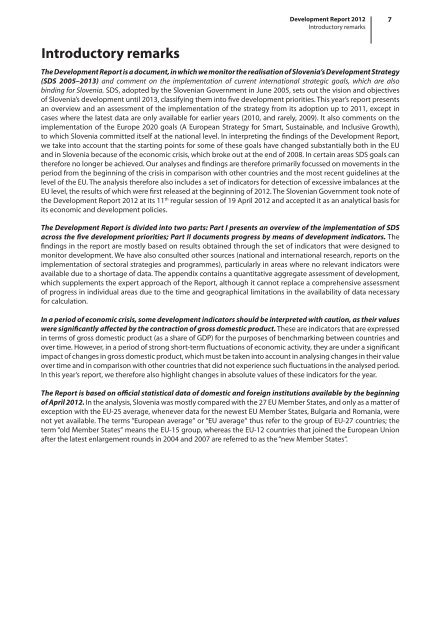development report 2012 - UMAR
development report 2012 - UMAR
development report 2012 - UMAR
You also want an ePaper? Increase the reach of your titles
YUMPU automatically turns print PDFs into web optimized ePapers that Google loves.
Development Report <strong>2012</strong><br />
Introductory remarks<br />
7<br />
Introductory remarks<br />
The Development Report is a document, in which we monitor the realisation of Slovenia’s Development Strategy<br />
(SDS 2005–2013) and comment on the implementation of current international strategic goals, which are also<br />
binding for Slovenia. SDS, adopted by the Slovenian Government in June 2005, sets out the vision and objectives<br />
of Slovenia’s <strong>development</strong> until 2013, classifying them into five <strong>development</strong> priorities. This year’s <strong>report</strong> presents<br />
an overview and an assessment of the implementation of the strategy from its adoption up to 2011, except in<br />
cases where the latest data are only available for earlier years (2010, and rarely, 2009). It also comments on the<br />
implementation of the Europe 2020 goals (A European Strategy for Smart, Sustainable, and Inclusive Growth),<br />
to which Slovenia committed itself at the national level. In interpreting the findings of the Development Report,<br />
we take into account that the starting points for some of these goals have changed substantially both in the EU<br />
and in Slovenia because of the economic crisis, which broke out at the end of 2008. In certain areas SDS goals can<br />
therefore no longer be achieved. Our analyses and findings are therefore primarily focussed on movements in the<br />
period from the beginning of the crisis in comparison with other countries and the most recent guidelines at the<br />
level of the EU. The analysis therefore also includes a set of indicators for detection of excessive imbalances at the<br />
EU level, the results of which were first released at the beginning of <strong>2012</strong>. The Slovenian Government took note of<br />
the Development Report <strong>2012</strong> at its 11 th regular session of 19 April <strong>2012</strong> and accepted it as an analytical basis for<br />
its economic and <strong>development</strong> policies.<br />
The Development Report is divided into two parts: Part I presents an overview of the implementation of SDS<br />
across the five <strong>development</strong> priorities; Part II documents progress by means of <strong>development</strong> indicators. The<br />
findings in the <strong>report</strong> are mostly based on results obtained through the set of indicators that were designed to<br />
monitor <strong>development</strong>. We have also consulted other sources (national and international research, <strong>report</strong>s on the<br />
implementation of sectoral strategies and programmes), particularly in areas where no relevant indicators were<br />
available due to a shortage of data. The appendix contains a quantitative aggregate assessment of <strong>development</strong>,<br />
which supplements the expert approach of the Report, although it cannot replace a comprehensive assessment<br />
of progress in individual areas due to the time and geographical limitations in the availability of data necessary<br />
for calculation.<br />
In a period of economic crisis, some <strong>development</strong> indicators should be interpreted with caution, as their values<br />
were significantly affected by the contraction of gross domestic product. These are indicators that are expressed<br />
in terms of gross domestic product (as a share of GDP) for the purposes of benchmarking between countries and<br />
over time. However, in a period of strong short-term fluctuations of economic activity, they are under a significant<br />
impact of changes in gross domestic product, which must be taken into account in analysing changes in their value<br />
over time and in comparison with other countries that did not experience such fluctuations in the analysed period.<br />
In this year’s <strong>report</strong>, we therefore also highlight changes in absolute values of these indicators for the year.<br />
The Report is based on official statistical data of domestic and foreign institutions available by the beginning<br />
of April <strong>2012</strong>. In the analysis, Slovenia was mostly compared with the 27 EU Member States, and only as a matter of<br />
exception with the EU-25 average, whenever data for the newest EU Member States, Bulgaria and Romania, were<br />
not yet available. The terms “European average“ or “EU average“ thus refer to the group of EU-27 countries; the<br />
term “old Member States“ means the EU-15 group, whereas the EU-12 countries that joined the European Union<br />
after the latest enlargement rounds in 2004 and 2007 are referred to as the “new Member States“.
















